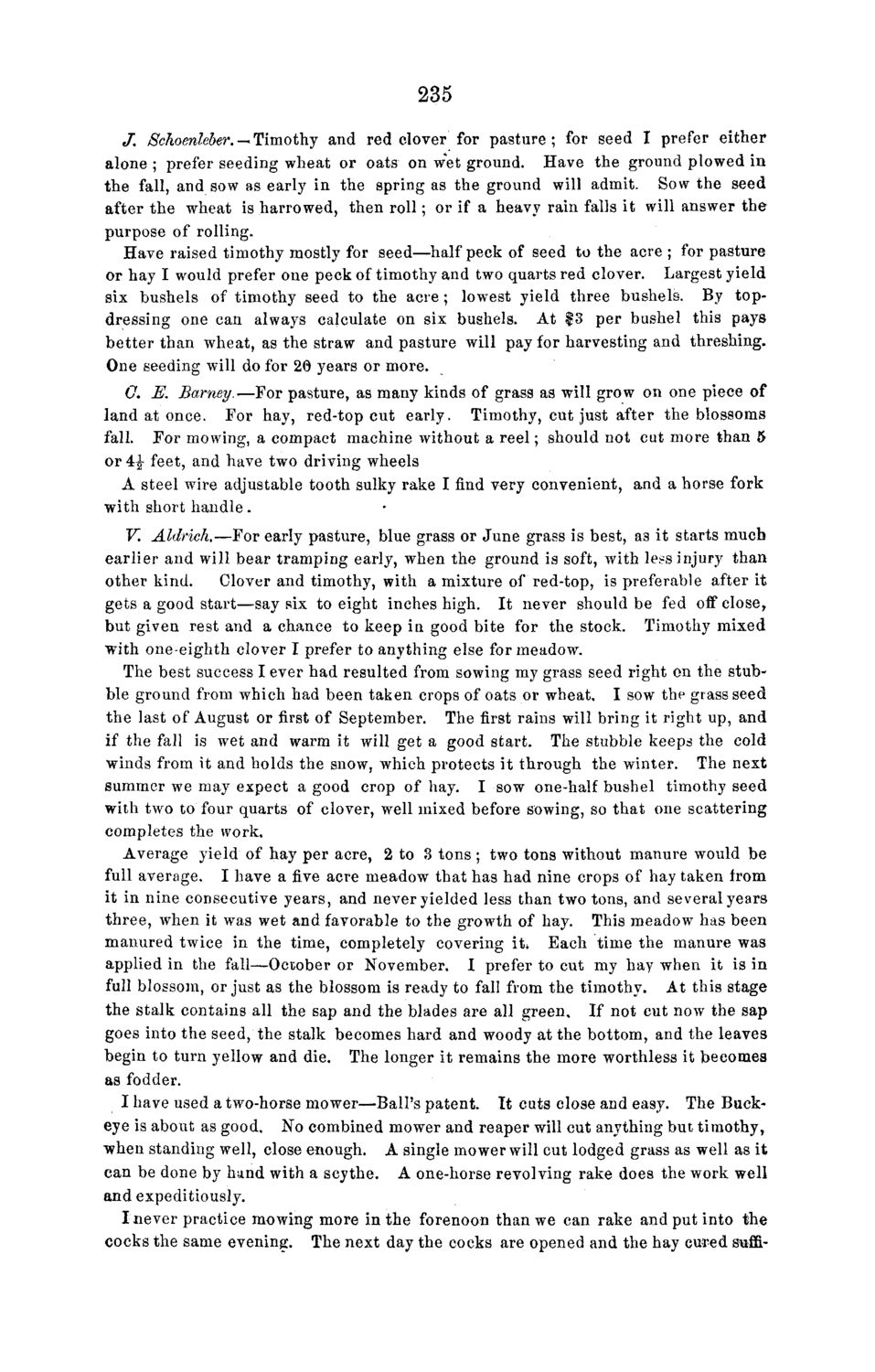| |
| |
Caption: Board of Trustees Minutes - 1868
This is a reduced-resolution page image for fast online browsing.

EXTRACTED TEXT FROM PAGE:
235 J. Schoenleber. — Timothy and red clover for pasture; for seed I prefer either alone ; prefer seeding wheat or oats on w*et ground. Have the ground plowed in the fall, and sow as early in the spring as the ground will admit. Sow the seed after the wheat is harrowed, then roll; or if a heavy rain falls it will answer the purpose of rolling. Have raised timothy mostly for seed—half peck of seed to the acre ; for pasture or hay I would prefer one peck of timothy and two quarts red clover. Largest yield six bushels of timothy seed to the acre; lowest yield three bushels. By topdressing one can always calculate on six bushels. At $3 per bushel this pays better than wheat, as the straw and pasture will pay for harvesting and threshing. One seeding will do for 20 years or more. G. E. Barney.—For pasture, as many kinds of grass as will grow on one piece of land at once. For hay, red-top cut early. Timothy, cut just after the blossoms fall. For mowing, a compact machine without a reel; should not cut more than 5 or 4£ feet, and have two driving wheels A steel wire adjustable tooth sulky rake I find very convenient, and a horse fork with short handle. V. Aldrich.—For early pasture, blue grass or June grass is best, as it starts much earlier and will bear tramping early, when the ground is soft, with less injury than other kind. Clover and timothy, with a mixture of red-top, is preferable after it gets a good start—say six to eight inches high. It never should be fed off close, but given rest and a chance to keep in good bite for the stock. Timothy mixed with one-eighth clover I prefer to anything else for meadow. The best success I ever had resulted from sowing my grass seed right on the stubble ground from which had been taken crops of oats or wheat. I sow the grass seed the last of August or first of September. The first rains will bring it right up, and if the fall is wet and warm it will get a good start. The stubble keeps the cold winds from it and holds the snow, which protects it through the winter. The next summer we may expect a good crop of hay. I sow one-half bushel timothy seed with two to four quarts of clover, well mixed before sowing, so that one scattering completes the work. Average yield of hay per acre, 2 to 3 tons ; two tons without manure would be full average. I have a five acre meadow that has had nine crops of hay taken from it in nine consecutive years, and never yielded less than two tons, and several years three, when it was wet and favorable to the growth of hay. This meadow has been manured twice in the time, completely covering it* Each time the manure was applied in the fall—October or November. I prefer to cut my hay when it is in full blossom, or just as the blossom is ready to fall from the timothy. At this stage the stalk contains all the sap and the blades are all green. If not cut now the sap goes into the seed, the stalk becomes hard and woody at the bottom, and the leaves begin to turn yellow and die. The longer it remains the more worthless it becomes as fodder. I have used a two-horse mower—Ball's patent. It cuts close and easy. The Buckeye is about as good. No combined mower and reaper will cut anything but timothy, when standing well, close enough. A single mower will cut lodged grass as well as it can be done by hand with a scythe. A one-horse revolving rake does the work well and expeditiously. I never practice mowing more in the forenoon than we can rake and put into the cocks the same evening. The next day the cocks are opened and the hay eu^ed sraffi-
| |